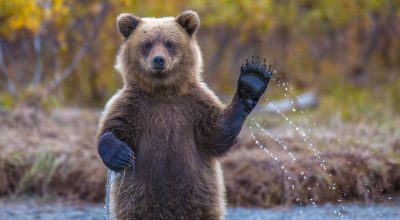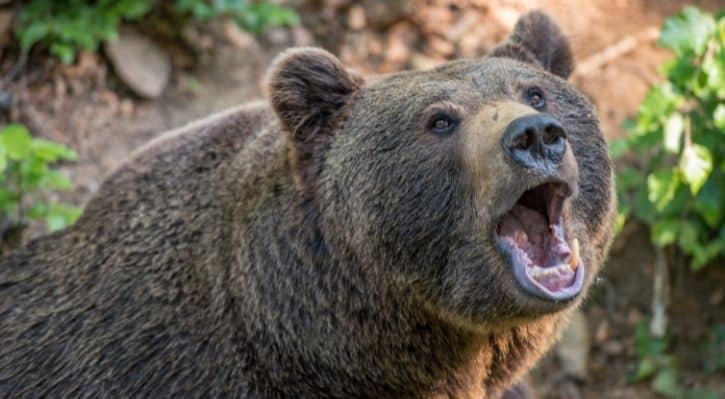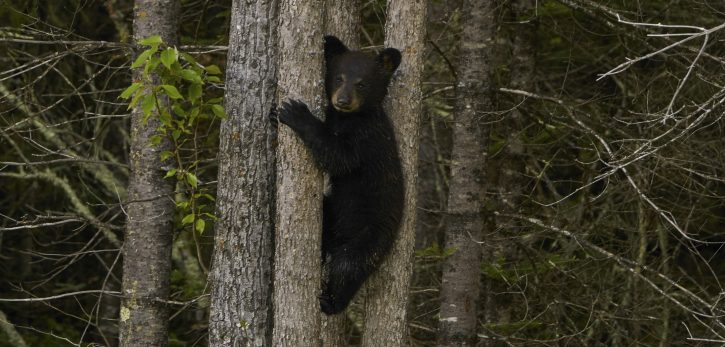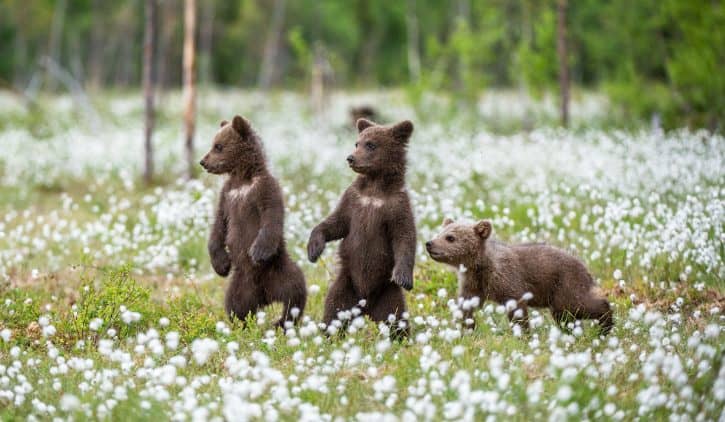What Do Bears Eat?
March 11, 2022June 10, 2020 by C.B. Daniels


The Short Answer: It depends on the type of bear. Polar bears are mostly carnivores and eat only meat, while panda bears are herbivores and eat only plants. Other bears are omnivores and eat grasses, vegetation, berries, seeds, insects, honey, fish, deer, elk, moose, bison, carrion, and human food/garbage.
Contents
2.1 How Do Bears Get Their Food?
2.2 What Do Baby Bears (Cubs) Eat?
4 How Often Should You Feed a Bear?
What Are Bears?
Bears are mammals that are members of the family Ursidae, which consists of eight living species and multiple other subspecies. The main bear species are the North American black bear, the brown bear, the Asiatic black bear, the sloth bear, the sun bear, the Andean bear, the polar bear, and the panda bear.
Fun Fact: The koala may be commonly (and incorrectly) called a koala bear, but it is actually most closely related to the wombat.
Like virtually all mammals, bears are warm-blooded, hairy vertebrates, meaning they have a vertebral column or spine. Bears also give birth to live young, and they lactate or produce milk to feed their young.
The largest bear species, the polar bear, is generally between 900-1500 pounds and stands at over five feet at the shoulder. Comparatively, the smallest species, the sun bear, is between 55-143 pounds and stands just over two feet at the shoulder.
The muzzle and snout of a bear is long, their ears are small and rounded, and they are covered in bushy fur. Polar bears are the only species that are all white, while the other species are black, brown, or a combination of colors.
They all have relatively large bodies with short legs, five curved, non-retractable claws that give bears their easily recognizable prints, and a stub of a tail. Bears generally have sharp hearing, great regular vision, and excellent night vision, but by far, their best sense is their sense of smell.
Bears have one of the best senses of smell in the whole animal kingdom, and they can sniff out an animal carcass from over 20 miles away – even when the wind isn’t blowing their direction.
Fun Fact: A bear’s sense of smell is seven times more powerful than a bloodhound’s, and their olfactory bulb – the part of the brain that processes scents – is five times larger than ours.
Bears can be found in North America, South America, Europe, and Asia. They collectively live in a variety of different habitats from glaciers to mountains to swamps, but each species has a specific range and habitat that they stick to.
For instance, polar bears only live in the Arctic – generally at the edges of pack ice. Similarly, the giant panda is only found in the Minshan and Qinling Mountains.
The ranges of all bear species have been impacted in some way by human activities, and six of the eight are currently on the endangered species list. The North American black bear and the brown bear are the only two that are not, though it is worth noting that certain subspecies of both are listed.
Bears can either be diurnal, meaning they are active during the day and sleep at night, or nocturnal, meaning they are primarily active at night. One of the most commonly cited facts about bears is actually one of the biggest misconceptions – they are not true hibernators.
Hibernation refers to a seasonal state of inactivity where an animal will lower its body temperature and slow its metabolic rate and heart rate. It is done to conserve energy and ride out periods of scarce resources, and true hibernators include woodchucks, bats, and ground squirrels.
True hibernators are practically impossible to rouse – they enter an almost comatose state that can last from days at a time to months. Bears, on the other hand, enter torpor, which is a state of lighter hibernation that is more easily reversed for situations like fleeing danger or feeding.
Hibernation is prompted by colder temperatures, hormonal changes in the bear, and scarcer food supplies. Entering into true hibernation is voluntary, whereas bears and other animals that enter into torpor don’t have a choice.
Fun Fact: Female bears will enter torpor while pregnant and wake to give birth.
Bears will eat voraciously and build up their stores of fat in the weeks leading up to hibernation to survive on while they are in torpor in their dens. Torpor can last for longer than 100 days in bears without them needing to eat, drink, or eliminate urine or feces.
Once they officially come out of hibernation, bears will remain sleepy and lethargic for multiple weeks. Once that wears off, they will resume a normal level of activity, sleeping minimally, until it’s time to prepare for the next year’s hibernation.
As for their social lives, bears are generally solitary creatures (of all the species pandas are the most sociable) but they will occasionally congregate for mating or when a resource is very abundant.
They are not usually territorial and will not actively defend a region against other bears, but males will occasionally kill cubs they encounter, and there may be an occasional contest for a food source or a mate.
Bears range from being generally fearful of humans like the North American black bear to downright aggressive toward them like polar bears. They are often considered a nuisance to campers due to trying to steal their food, and bears that grow too comfortable around humans can be especially dangerous.

Some bears are the apex predators of their ecosystems – meaning that no other animals hunt or prey on them, but some bears in Asia are actually food for tigers. They are expert climbers and swimmers, and can even run up to 37mph for short durations.
What Do Bears Eat?
Polar bears are mostly carnivores, or meat-eating, while pandas are strictly herbivores or plant-eating. The other bear species are all omnivores, meaning they eat both plants and animals, and all bears can be scavengers or creatures that will eat dead animals
While polar bears primarily eat seals and a panda’s diet consists of 99% bamboo, the other species are much less picky. These bears will eat everything from plants and insects to fish and other animals.
How Do Bears Get Their Food?
Foraging is the main way that bears find their food. Pandas will search the forests for bamboo to eat, while the other more omnivorous bears will look for edible vegetation, berries, seeds, and insects.
These bears will generally only eat carrion if their other food sources are in short supply or it is readily available. They are more likely to hunt for other food like insects, fish, and young or sick deer, elk, and moose.
Polar bears, on the other hand, primarily hunt for their food. They will spend most of their time prowling the ice and waiting for seals to surface, but they have also been known to eat whale carcasses.
What Do Baby Bears (Cubs) Eat?
Bears reach sexual maturity around five years old on average, and mating season is generally in the late spring to early summer months. Bear cubs have a 200-day gestation on average with variation from species to species and are born in the winter generally as twins.
Fun Fact: Once an egg has been fertilized, a bear can actually delay its implantation in the uterus until the start of denning season in order to time the cub’s birth.
Once the cubs are born, they will nurse for around six months, drinking their mother’s fatty milk as their sole source of sustenance. Their mom will still be in hibernation until the springtime, even as the cubs nurse and grow, and the cubs will live mostly in trees once their mom comes out of hibernation while they are still nursing.
Cubs will sample what their mothers eat while they are nursing, and once they are weaned off of milk cubs will eat grasses and other vegetation, berries, insects, birdseed, and other foods that are easily found foraging.

Bear cubs stay with their mother for up to two years after birth and progressively learn how to hunt for live food as they approach sexual maturity around 4-5 years. Bears in the wild can live for an average of 20 years with polar bears living for the longest (25 on average) and North American black bears living the shortest (19 years on average).
The two exceptions are panda cubs and polar bear cubs – panda cubs eat bamboo once they wean off of milk and will continue to eat bamboo primarily for the rest of their lives. Polar bear cubs will learn to hunt seals with their moms after they wean and will share her kills until they are old enough to hunt for themselves.
What Do Adult Bears Eat?
Once bears leave the den around two years old, they will eat much of the same things that they foraged for as cubs. Grasses, roots, berries, and other fruits, nuts, and sedges are all large parts of the diets of omnivorous bears and bears also have a taste for honey.
Fun Fact: Winnie the Pooh wasn’t lying when they portrayed bears as loving honey, and bears can raid bees’ nests for honeycomb because their skin is too thick for the bees to penetrate with their sting.
Bears won’t only eat the honey from beehives, they have also been known to eat the bees themselves as well as wasps, termites, moths, ants, grubs, worms, and other insects. While small compared to the bear, insects are a great source of protein that is easily accessible.
As for the food they hunt, bears are great fishers and will readily catch trout and salmon in rivers. They can dig up rodents like mice, and they have also been known to hunt deer, elk, moose, and even bison.
Bears won’t turn their nose up at an easy meal and will eat carrion if they come across it, but when food is scarce, they will actively seek it out using their powerful sense of smell. This sense of smell is also what leads bears to human food and garbage, which they will readily eat, and campers have come up with many different tools and tricks to keep bears out of their food from hanging it in trees to using bear-proof canisters.
Bears have a digestive system that is similar to ours, but they have longer intestines that are better suited to digesting and extracting the meager nutrients from plant matter.
In captivity, bears are generally fed red meat and fish in addition to fresh greens, fruits and vegetables, and formulated omnivore food.
If you encounter a bear in the wild, DO NOT FEED IT! Bears that grow accustomed to humans also become unpredictable and significantly more aggressive, not to mention they will associate things like tents, cars, garbage cans, and other human structures with food and will destroy them if they think there is food inside.
Bear Food Options
Bears in zoos and other wildlife conservation centers are easily fed because they can eat such a wide variety of foods. Here are some of the best options:
- Grasses
- Spinach
- Lettuce
- Kale
- Sprouts
- Squash
- Zucchini
- Berries
- Bananas
- Oranges
- Salmon
- Trout
- Beef
- Pork
- Venison
- Other red meats
- Omnivore formulated food
How Often Should You Feed a Bear?
One again, never feed a bear that is in the wild for your safety, the safety of others, the safety of your property, and the safety of the bear.
In captivity, bears should be offered small amounts of food multiple times per day with a variety of foods in each meal. This would most closely match how they would eat in the wild, and in the autumn, bears can be offered food as many as six times per day in order to mimic the preparation for hibernation.
That being said, bears are NOT pets. And they should not be kept as pets. They are extremely powerful and can easily kill a human without even intending to.
Summary of What Bears Eat
Bears are mammals of the family Ursidae, with eight main species and multiple other subspecies alive today.
They are known for their incredible sense of smell as well as entering into a pseudo-hibernation or torpor during the winter months.
Bears are found in a variety of environments, and different bear species have different diets. Pandas are generally herbivores that eat mostly bamboo, polar bears are carnivores that mainly eat seals, and the other bear species are omnivores that eat a combination of plants and animal matter.
Adult bears in the wild will forage for grasses, roots, seeds, berries, honey, and insects, and they will hunt for rodents, fish, and large, hooved animals like deer, elk, moose, and bison.
Bear cubs in the wild will drink their mother’s milk for the first six months, then will start to forage for food with their mother while learning to hunt.
In captivity, bears can eat multiple smaller meals per day, and they can be given more in the months before they go into hibernation. They can eat most of the same foods in captivity that they would find in the wild, as well as added vegetables and fruits.
You should never feed a bear in the wild. And bears should absolutely not be kept as pets.
Other animal articles
Hi my name is C.B. Daniels and I make websites. I’ve also always been fascinated by animals. I thought that some of the information about animal diets and pet names was a little thin. So I figured I’d make this site to remedy that! I hope to make this site a hub for information about what animals eat, fun names you can use for your pets, and general animal information. Hopefully, you’ll find all the information about animals you are looking for and much more!
Latest posts by C.B. Daniels (see all)
- Can Rabbits Eat Grapes? - November 12, 2022
- Can Rabbits Eat Cucumbers? - November 3, 2022
- Can Rabbits Eat Spinach? - November 3, 2022